In the lush, rolling pastures of the British Isles, a gentle giant roams a creature as rich in history as it is in cream. The Guernsey cow, an enchanting breed that has captured hearts and stomachs alike with its distinct golden milk and charming demeanor.
A dairy enthusiast or simply curious about this striking animal, understanding the Guernsey cow offers a fascinating glimpse into sustainable farming practices and agricultural heritage.
Guernsey History
The Guernsey cow, with its striking golden coat and gentle demeanor, may not boast an extravagant narrative in the annals of livestock history, but its tale is one steeped in quiet resilience.
Originating from the picturesque island of Guernsey in the 17th century, these cows emerged from a blend of two French breeds Brindle and Froment du Léon crafted under unique conditions that honed their exceptional milk-producing capabilities.

Interestingly, their development was so tightly regulated that until 1995, strict laws prohibited importing them to preserve their genetic purity.World War II introduced unforeseen twists to this tranquil existence; reports suggest that during the chaos, some Guernseys escaped captivity and integrated with other herds like Spahr and Opperman.
Such incidents only reinforced their adaptability and allure on a global scale. The time of 20th century rolled around, these charming cows had not only earned recognition for their rich milk flavor but had also become symbols of sustainable farming practices a role they continue to play today as dairy enthusiasts seek out heritage breeds for quality over quantity.
Appearance of Guernsey
The appearance of Guernsey cattle is nothing short of striking, and it’s this visual appeal that sets them apart in the bovine world. Their unique reddish-white coat, adorned with irregular brown patches reminiscent of Sahiwal cattle, creates a breathtaking tableau that captivates farmers and enthusiasts alike.
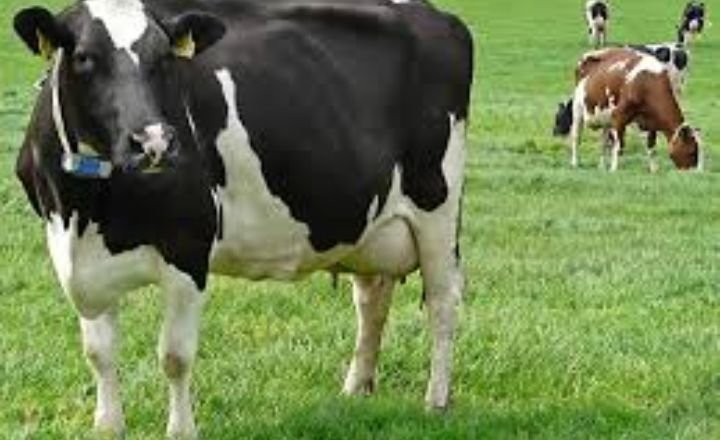
It’s remarkable how this coat not only signifies their breed but also serves as a testament to their adaptability in various environments from lush pastures to more rugged terrains.
Their distinctive coloring, Guernseys excel in physical conformation. Their strong backs and smoothly blending shoulders demonstrate both elegance and robust health. The wide loin and rump provide a solid foundation that ensures these animals can support substantial milk production, while the deep barrel contributes to overall robustness.
Weight
The weight of Guernsey cows can be somewhat elusive, even for experienced farmers and enthusiasts. A male Guernseys typically tip the scales between 600 to 700 kgs, female counterparts usually fall within the range of 450 to 500 kgs.
These variations may stem from factors such as genetics, diet, and overall health, making it essential for caretakers to consider these variables when evaluating their herd.
Height
Guernseys, often celebrated for their rich guernsey golden-brown coats and gentle demeanor, stand out as medium-sized cows characterized by their impressive stature. Achieving heights of up to 54 inches, or even more in certain cases, these animals embody a unique blend of strength and grace that captivates both farmers and livestock enthusiasts alike.
The moderate size of Guernseys not only makes them suitable for various farming operations but also allows for easier management compared to larger breeds.
Distribution
The remarkable journey of the Guernsey cow origin from its native Channel Island to farms across the globe is a testament to its adaptability and appeal. Post-World War II, these gentle giants captivated dairy farmers with their rich creamy milk and docile temperament, quickly becoming a favorite in places like the UK and North America.
Their unique genetics produce high butterfat content milk, making them an essential asset for cheese makers and ice cream producers worldwide.
Guernsey cows stand as symbols of sustainable farming practices in countries such as South Africa and Australia, where they contribute significantly to dairy production while requiring less feed compared to other breeds.
This makes them not only environmentally friendly but also economically viable for farmers looking to optimize resources in diverse agricultural landscapes.
Temperament
The remarkable temperament of Guernsey cows is a key reason they capture the hearts of farmers and animal lovers alike. Renowned for their rich, kind, and gentle nature, these cows are not just livestock; they become integral members of the family.
Owners often recount how easily Guernseys forge deep bonds with them, responding to voices with affectionate nudges or soft moos that speak volumes about their desire for companionship. This emotional connection enriches farm life, transforming routine chores into rewarding moments filled with affection.
Use of Guernsey Cow
Guernseys are not just prized for their impressive milking capacity but also for their gentle temperament, making them a favorite among dairy farmers. These cows thrive in calm environments and exhibit sociable behavior, which makes handling them much easier than other breeds.
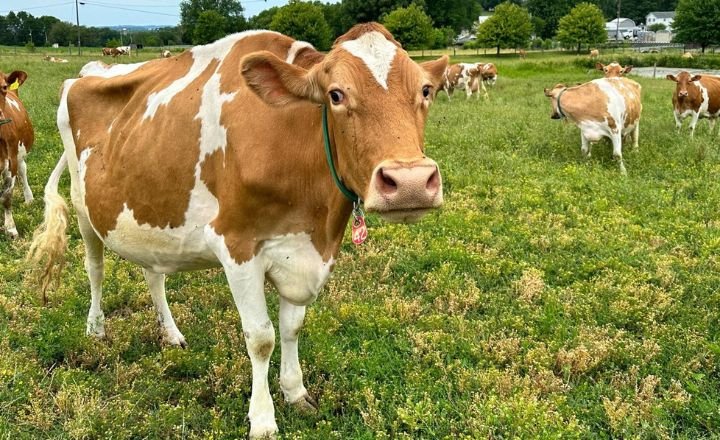
Their placid nature allows for efficient milking routines, contributing to the smooth operation of dairy farms. Having a herd that is easy to manage can significantly reduce stress levels for both the animals and the farmers.
The nutritional profile of Guernsey cow milk is another fascinating aspect worth exploring. With its high beta-carotene content giving it a distinct golden hue, this milk stands out not only in taste but also in quality.
The vibrant color hints at its richness in vitamin A, essential for numerous health benefits ranging from improved vision to enhanced immune function. Awareness grows around nutrient-dense food sources, Guernsey milk is increasingly sought after by health-conscious consumers who prioritize natural and wholesome products.
Everything Else You Need To Know About Guernsey Cow
Guernsey Is Bred And Raised For Utility, Not Good Looks
Overlooked for their average appearance, Guernsey cows are far more than just a humble addition to the farm. Known for their stunningly rich yellow milk, which is packed with beta-carotene, these cows contribute significantly to both dairy and meat industries.
This unique nutritional profile not only enhances the flavor of various dairy products but also makes for gourmet-quality beef that delights palates and elevates culinary experiences.
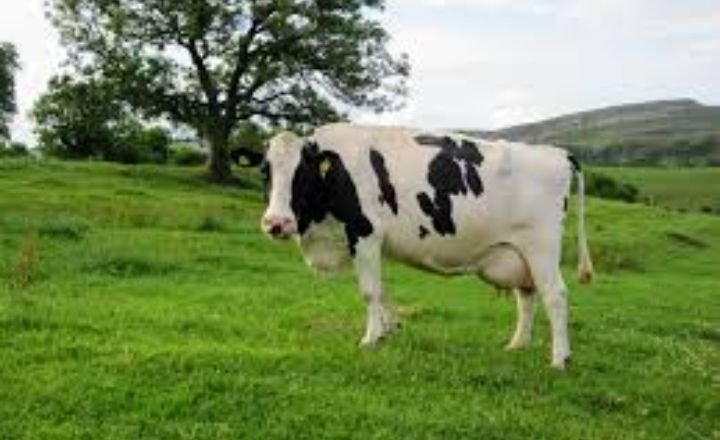
Their utilitarian appeal, Guernseys embody a perfect blend of gentle temperament and robust health, making them ideal companions on any farm.
Farmers appreciate their efficiency in converting feed into high-quality milk and meat while maintaining a manageable size compared to larger breeds.
Guernseys Require 20 To 30% Less Feed To Produce Milk
Optimizing feed and ensuring cow comfort are pivotal factors in enhancing milk production, particularly evident in Guernsey cows. These resilient animals can yield impressive milk volumes while requiring 20 to 30% less feed compared to other breeds.
This efficiency not only makes Guernseys economically viable but also supports sustainable farming practices; with less feed input, farmers can minimize their environmental footprint while maximizing output.
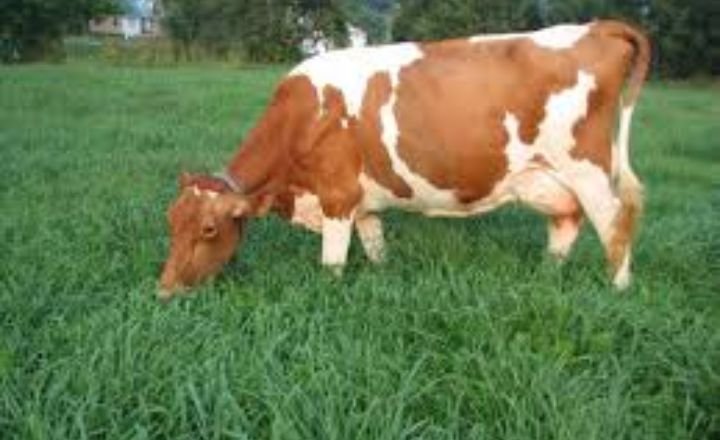
Guernsey cows apart further is their early maturity. They can conceive as early as twenty-two months, offering a substantial advantage over regular cow breeds that typically reach maturity at around twenty-four months.
This quicker turnaround means farmers enjoy a shorter wait time before calves join the dairy herd, amplifying productivity and profitability from an earlier stage in the animal’s life cycle.
This Cow Breed Is Recorded To Have Minimum Calving Complications
Calving complications can significantly impact both the financial and emotional aspects of livestock management. A many breeds experience a range of challenges during calving, leading to increased veterinary bills and potential loss of both cow and calf, Guernsey cattle stand out in this regard.
Their remarkable resilience allows them to thrive even when bred with heavier beef breeds, making them an attractive option for farmers looking to enhance their herds without inviting trouble.
One key factor contributing to the Guernsey’s success is their unique physiology combined with a calm disposition that promotes easier births. This breed’s lower incidence of calving issues not only alleviates stress for farmers but also enhances herd stability, ensuring livestock longevity and productivity.
A investing in Guernseys could lead to a more sustainable operation, reducing unnecessary vet costs while maximizing calf survival rates an outcome that’s beneficial for both agriculture enthusiasts and animal welfare advocates alike.
Guernseys Have An Ideal Farm Animal Temperament
Guernsey cows are celebrated not just for their rich, golden milk but also for their delightful personalities that charm anyone who encounters them. Fans of these remarkable animals often describe them as docile and playful, traits that set them apart in the world of livestock.
Their gentle demeanor fosters a nurturing interaction with farmers, making day-to-day care a rewarding experience rather than a chore. A walking through the fields and experiencing an almost palpable bond formed between human and animal a synergy that enhances both farming productivity and emotional well-being.
This Cow Breed Has An Exceptional Heat Tolerance
Guernsey cows are a breed that exemplifies the beauty of nature’s design, combining functionality with an intriguing resilience to heat. Their reddish white coats not only capture attention but also play a vital role in their adaptability, reflecting sunlight and regulating body temperature during sweltering summer days.
This natural boon eliminates the need for artificial cooling systems, making them a sustainable choice for farmers looking to reduce energy costs while maintaining animal welfare.
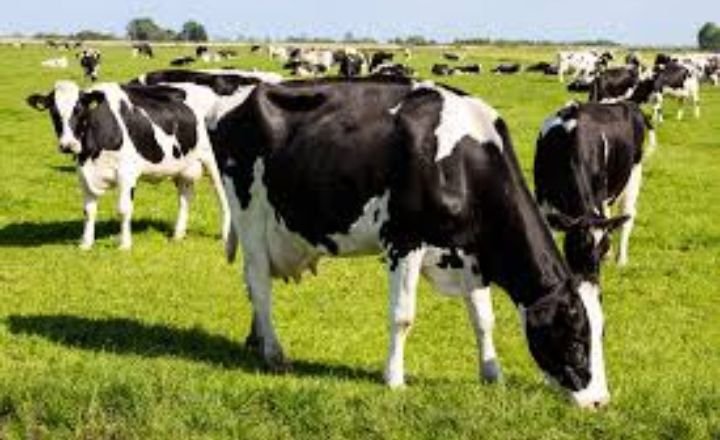
The Milk Produced By Guernsey Is Far More Superior Than The Regular Milk
The allure of Guernsey cows lies not only in their beautiful, rich red and white coats but also in the exceptional quality of milk they produce. This island breed offers a nutrient-dense dairy delight that stands out in the agricultural sector.
A 30% more cream than regular milk, Guernsey milk lends itself perfectly to making rich butter and cheeses that tantalize the taste buds, elevating culinary creations to gourmet heights.
But it doesn’t stop at creaminess; the elevated levels of protein (12% more), vitamin A (25% more), and calcium (15% more) make Guernsey milk a powerhouse of nutrition, appealing to health-conscious consumers looking for wholesome products.
The impressive 33% boost in vitamin D enhances its appeal further, especially for those seeking natural sources to support immune health and bone strength.
Guernseys Can Be Horned Or Naturally Polled
The evolution of Guernsey cattle since they left their island home is a testament to the complex interplay between tradition and modern agricultural practices. These cows were known for their distinctive guernsey cow characteristics, including their striking coat colors and notably horned appearance.
The breed began to intermingle with other breeds around the world, the genetic diversity introduced both remarkable strengths and unforeseen changes. Mostly Guernseys can still be recognized by their horns an emblem of their heritage a growing segment of the population has transitioned into being naturally polled.
Guernsey Cow Breed Has Got A Nickname As Well
The Guernsey cow’s golden-hued coat isn’t just a feast for the eyes; it serves as a vivid reminder of the breed’s rich heritage and consistent prominence in dairy farming. Originating from the picturesque island of Guernsey in the English Channel, these majestic animals are renowned for their striking appearance and gentle demeanor.
Yet, it’s not merely their beauty that captivates farmers and cheese aficionados alike. It’s the luscious, golden milk they produce, laden with beta-carotene, which contributes to its vibrant hue and exceptional nutritional profile.
In Some Parts Of The World, Guernseys Are Not Desirable For Meat
Despite their rich, buttery milk and picturesque charm, Guernsey and Jersey cattle often find themselves overlooked in the beef market. At first glance, one might assume that because their meat mirrors the flavors of more beef-centric breeds, they would be welcomed with open arms by culinary enthusiasts.
This perception belies a nuanced truth: these breeds are primarily optimized for dairy production rather than meat quality. While a perfectly grilled steak from either breed may tantalize your taste buds, factors such as marbling and fat content still play crucial roles in culinary desirability.
The irony lies in how these dairy-focused breeds possess an intrinsic flavor profile that can compete with traditional beef varieties yet still struggle to carve out a niche on butcher shop counters.
Let Alone Milk, The Guernsey Butter Has A Distinguishing Color As Well
The distinctive yellow hue of Guernsey cow butter is more than just a visual delight; it’s indicative of its rich nutritional profile. This vibrant color comes from the high beta-carotene levels in Guernsey milk, sourced from pastures teeming with lush grasses and wildflowers.
A standard butter, often sanitized to a paler tone, this golden variant hints at its flavorful complexity and robust personality.
A spread this golden butter on warm bread or use it in cooking, you unlock not just taste but also an appreciation for traditional dairy farming practices.
The commitment of Guernsey farmers to sustainable grazing allows their cows to produce milk that carries both character and depth—attributes that are notably reflected in the butter’s richness.
The Milk Produced By Guernsey Cows Get Sold At Higher Prices
The allure of Guernsey cow milk lies not just in its rich, golden-hued creaminess but also in its nutritional powerhouse quality. This milk’s high levels of cream, protein, calcium, and vitamins A and D set it apart from regular dairy offerings.
Interestingly, the distinct richness makes it immensely sought after in gourmet circles and among health-conscious consumers, it’s the nuanced flavor profile that elevates it to a different culinary stratum. Chefs often gravitate toward Guernsey milk for artisanal cheese production or even delightful desserts that truly showcase its creamy texture.
SUMMARY
Guernsey cows stand out not only for their striking appearance and gentle temperament, but also for their exceptional milk quality rich in beta-carotene. Their adaptability to various farming environments makes them a valuable asset to both small and large-scale dairy operations. With proper care and management, these cows can thrive and contribute significantly to sustainable agriculture.
